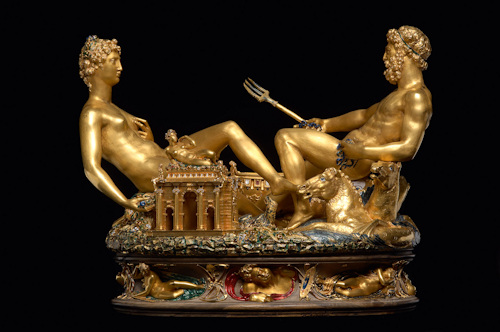
Most salt and pepper pots might cost you a few euro from the likes of Ikea. The Saliera, however, would set you back something more than €50 million (hopefully that includes free shipping).
- Fabulous golden salt cellar from the mid-16th century
- Originally created by Benvenuto Cellini for King Francis I of France
- Once thought lost after an art theft
- Entered Habsburg hands as a gift to Archduke Ferdinand II
- Not actually for sale (do I need to say this?)
- See also:
The Cellini salt cellar

(Salt cellar (Saliera) Benvenuto Cellini 1540-1543, Paris, gold, enamel, ebony, ivory 26.3 cm x 28.5 cm x 21.5 cm © Kunsthistorisches Museum Wien)
The Saliera occupies pride of place in the Kunstkammer Chamber of Wonders at the Kunsthistorisches Museum (better known as the KHM), one of my top 10 places to visit in Vienna.
Myriads of astonishing items fill the Kunstkammer, but the Saliera towers over everything else in this diverse collection of exhibits.
Ostensibly, what you have is a piece of tableware to hold salt and pepper. And two receptacles (a ship and temple) do indeed serve that purpose.
But it’s so much more than that, as the photo above demonstrates.
Taking a pinch of salt or pepper from the golden Saliera represents an act of submission, an acknowledgement that you remain mere dirt on the shoe of the owner’s prestige and power.
Because it’s hard to maintain a sense of superiority over your host when the value of their salt cellar probably exceeds your entire net worth.

(Ferdinand II of Tyrol, one-time owner of the Saliera
Image courtesy of the Rijksmuseum)
Inside the gallery it calls home, the Saliera rests in its own free-standing glass cabinet, spotlights creating a pool of light in a low-lit room.
Two figures rest on the work’s surface, legs intertwined. A man (“Sea”) holds a trident and sits back almost lasciviously, six-pack to the fore. Opposite him, a woman (“Land”) reclines with one hand pinching a breast.
Elsewhere, a few glass display cases hold other French treasures. For example, some 16th-century cameos, a pendant of gold and enamel, or 16th-century painted enamel tableware from Limoges. These are just window dressing in the presence of the Saliera.
Gold is the piece’s dominant theme, urged into place by the hands of Benvenuto Cellini, an Italian goldsmith, sculptor, and all-round creative genius. Few of his works have survived, but the Saliera is one of them.
Cellini completed his salt cellar in 1543 as a commission for Francis I, King of France.

(An 1841 print of Benvenuto Cellini in his studio based on a painting by Joseph Nicolas Robert-Fleury; photo courtesy of the Rijksmuseum)
Later that century, King Charles IX made a gift of it to Archduke Ferdinand II of Tyrol around the time of the former’s marriage to the latter’s niece, Elisabeth of Austria (the daughter of the Habsburg emperor, Maximilian II, who was Ferdinand’s older brother).
I sincerely hope Ferdinand’s wedding gift to the pair was more than a voucher for a Paris spa or there might have been some tension at family reunions.
The Archduke was a noted sponsor of the arts and architect of the prestigious Schloss Ambros collection that later passed into the hands of the KHM.
The story does not end there, though. The Saliera actually fell victim to an opportunistic theft in 2003. Fortunately for us, a contrite thief led police to its whereabouts just under three years later.
How to get to the Saliera
Once you’ve found the KHM, enter the main entrance hall with its glorious dome; the stairs to the left take you up into the Kunstkammer.
Once inside the Kunstkammer, go straight on through the galleries until you can’t go any further and have to turn left or right. On the left is Gallery 24 (Saal XXIV) and inside is the Saliera.
Address: Burgring 7, 1010 Vienna